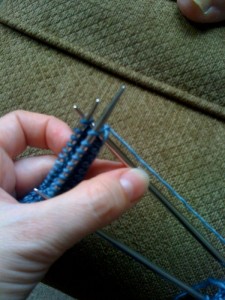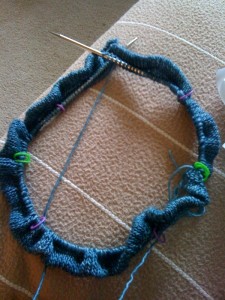I think we are on part three…now I am not sure. Greetings from Rockford IL! My grandmother passed away over the weekend, and I have been here with my family for most of the week. I am sorry to miss you all at the event tonight, but I will see you tomorrow!
I figured that I owe you all our next step (and I needed some knitting stress relief). We left off at the turned hem. The directions have you put the wrong sides of the fabric together and knit the provisionally held stitches together with your live stitches, while also changing to the larger needle. Here is mine:

On the next row (a wrong side row), you will place all of your markers. I suggest that you have two or three different colors of markers. I skipped the “band marker” since it was only five stitches from each end and was to remind me to work the first and last five stitches in garter. I used purple for the dart markers (of which there are four) and green for the markers that are placed on either side of the “seam stitch” (also four total markers). Connie uses a slipped stitch on every RS row to create the illusion of a seam on the sides of the sweater. Here is my work with markers:

There is a purple dart marker, two green side seam markers, then a purple dart, followed by another purple dart marker on the other side of the back, then green side seam markers and the last purple dart marker. Have the side seams marked with two makers helps to remind you to do something different at that point. Note that on the wrong side rows (purl rows) you will not slip that side seam stitch. For the first 4-4.5 inches (check the pattern for your size), you will ignore the dart markers and simply slip the stitch that is between your two side seam markers on RS rows. BUT, are you using a hand dyed yarn? You MUST alternate balls, particularly if you are using Madelinetosh! Otherwise, the bottom half of your sweater is likely to be a different color than the top half.
How do I alternate hand dyed yarn?
It is on the first RS row that I began to incorporate another ball of yarn. I did work the entire turned hem without joining a second ball. When I joined my new ball, I did so at the first side seam on a RS row. By switching out on a side seam, the drags of yarn won’t be seen on the front edge. If the sweater had a picked up and knitted front band, I could switch out at the beginning of a row, however, since this band is knitted at the same time as the body of the sweater, it will look better if the yarns are switched out on a side seam. So on my first RS row, I knitted to the first side seam, I slipped the first marker and my side seam stitch, as the pattern indicates. I slipped the second marker and then knitted the next stitch with a new ball of yarn. I will then complete the RS row and a full WS row and switch again when I have reached the old ball at that side seam on my next RS row. So I only switch balls on RS rows.
If I haven’t convinced you yet that you need to alternate balls of yarn, do some searching of images online for sweaters knit from Malabrigo and you will see plenty of examples of the bad things that happen when you don’t alternate. Yes Cameronne, that means you too. Now whining. Alternate!
